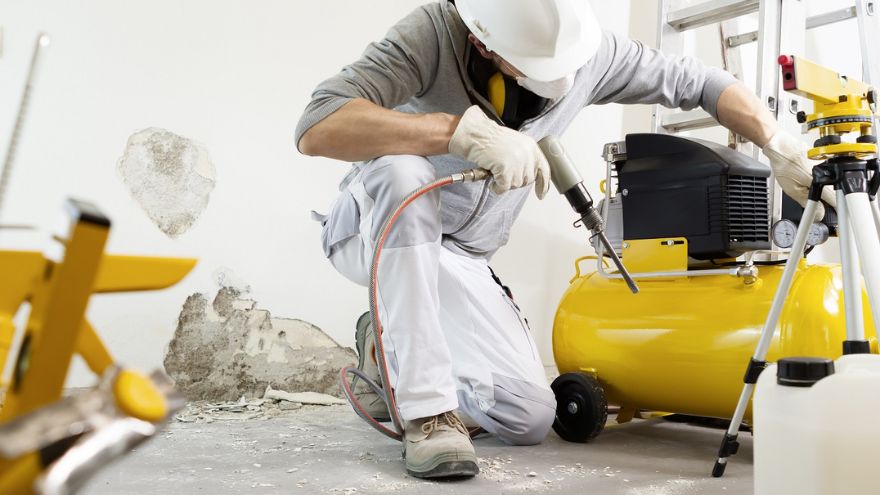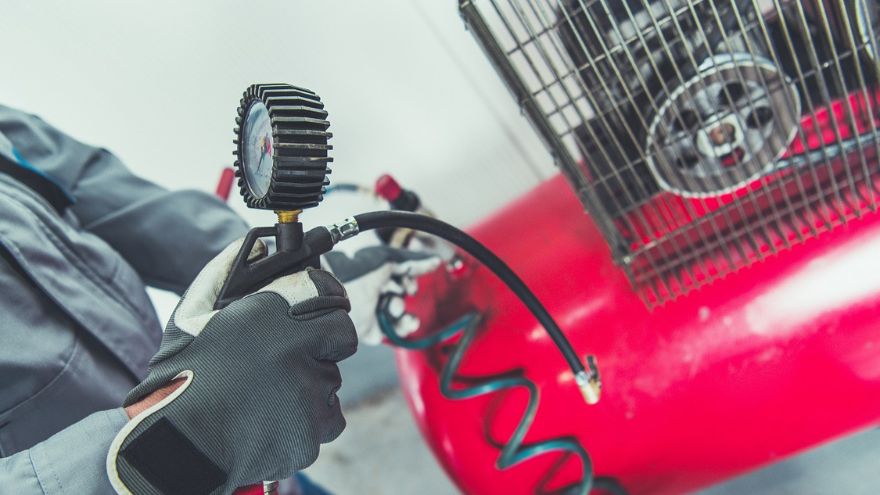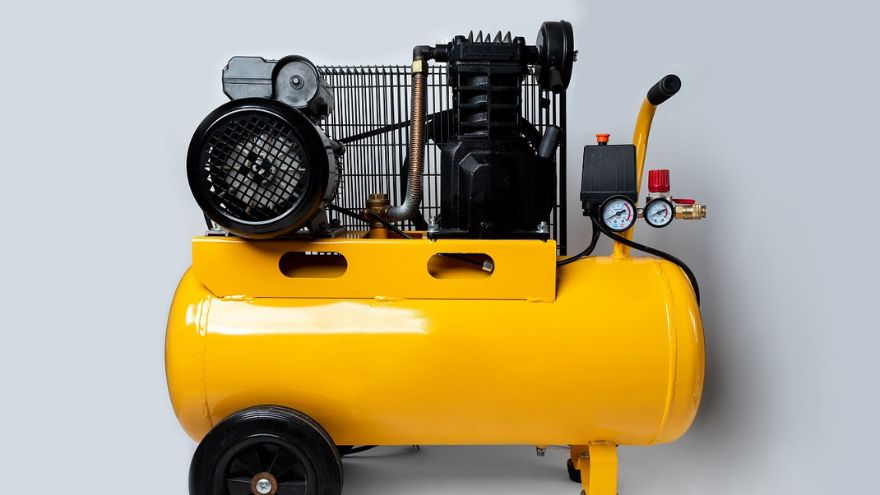A compressor is a tool with a wide range of applications not only in industry, but also at home. Are you wondering what equipment will work best in your home, garage or garden? We invite you to read our review, which contains answers to the most frequently asked questions.

In this article we will introduce you to:
- what are compressors;
- what are their types;
- what to consider when choosing your own compressor for your home;
- what are the most popular compressors for home use in our wholesale offer.
Compressor – what exactly is it?
Compressors are devices from the compressor group used to increase the gas pressure or force its flow . They are used both in production halls and professional workshops, as well as at home. Compressors make many everyday activities easier , such as checking the air pressure in tires, blowing out equipment or rooms, and even spray painting, varnishing or sandblasting.
Before you start looking for a specific product, determine the purpose of the compressor. It is not worth overpaying for a compressor that you will not use to its full potential, or buying cheaper devices that will not meet your expectations.
Check out the compressors offered by the Onninen wholesaler
Types of compressors
Compressors can be divided according to several criteria. The most basic division is based on the structure of the compressor - we distinguish positive displacement compressors (membrane compressor, piston compressor, screw compressor, vane compressor, rotating hammer compressor) and flow compressor (radial, diagonal, axial, gravel compressor). Others include: lubrication (oil and oil-free compressors), mobility (stationary, portable) or power sources (electric, combustion).
Since we are talking about selecting a compressor for home conditions, we will omit flow devices. Among the positive displacement compressors, we will focus on two types adapted to work at home, in the garage or in the garden : diaphragm and piston compressors.
Piston vs. diaphragm compressor
In a diaphragm compressor, the compressor's design includes the use of a diaphragm that moves compressed air with a piston. Since the piston has no contact with the compressed air, it is free from contaminants . This is why diaphragm compressors are often used in places that require the highest quality and purity of air, e.g. in dental offices, food, pharmaceutical or paint markets.
If you want equipment that is slightly less efficient, but ecological, consider purchasing a diaphragm compressor. However, our experience shows that piston compressors in oil or oil-free versions are a more common choice for homes .
Oil or oil-free compressor?
 The principle of operation of both devices is the same. The difference is that the piston of an oil compressor must be lubricated with oil, so it requires additional maintenance . The piston in an oil-free compressor is made of a material with a low coefficient of friction, so it does not need lubrication.
The principle of operation of both devices is the same. The difference is that the piston of an oil compressor must be lubricated with oil, so it requires additional maintenance . The piston in an oil-free compressor is made of a material with a low coefficient of friction, so it does not need lubrication.
The oil compressor has a more efficient compressor, adapted to continuous operation , which is why it is more often found in professional car workshops or tire repair plants. Although it is heavier than the oil-free type, many models are equipped with wheels that make it easier to move from place to place. The disadvantage of oil compressors is the possibility of small amounts of oil getting into the compressed air during operation. Such devices also take up more space, so make sure you have appropriate conditions to store and transport them freely. Among the disadvantages of "oil vodkas" it is also worth mentioning their quick heating and long cooling.
Oil-free variants are smaller, lighter and quieter in operation than oil-based ones. However, this translates into lower efficiency and unsuitability for continuous operation. A small and light compressor will be used to inflate a mattress, ball or inflatable toy. There are also larger, yet still portable, oil-free variants on the market for use in the workshop. The oil compressor is environmentally friendly and easy to use . It is recommended for people who are less advanced in working with this type of devices and often expect a simple, portable device for undemanding home or workshop work.
Check out the compressors offered by the Onninen wholesaler
What else should you consider when choosing a compressor for your home?
In addition to the construction (type of compressor) and type of lubrication, when selecting a compressor, it is best to take into account the following parameters:
Compressor efficiency
One of the basic parameters of the device that determines whether it will meet all your needs. The capacity of a home compressor should be in the range of 150-300 liters per minute.
Tank capacity
For household chores, equipment with a capacity of up to 10 liters should be sufficient. For painting or sandblasting, choose stationary devices with a capacity of approximately 50 liters. Remember, however, that a larger capacity also means more space and more weight .
Maximum compressor pressure
Most activities at home and in the garage can be performed with a compressor whose pressure does not exceed 6 bar . However, if you need a slightly more efficient device, choose the 8-10 bar range.
Accessories and additional functions
 Pay attention to the basic equipment of the device. Most compressors are factory-equipped with a spiral cable with appropriate fittings (for bicycle valves, balls, mattresses), a gun with a pressure gauge for inflating car wheels and a blowing gun. If you want to use the compressor for other activities, you will probably need to purchase additional accessories. You will also find devices on the market that offer e.g. remote pressure regulation.
Pay attention to the basic equipment of the device. Most compressors are factory-equipped with a spiral cable with appropriate fittings (for bicycle valves, balls, mattresses), a gun with a pressure gauge for inflating car wheels and a blowing gun. If you want to use the compressor for other activities, you will probably need to purchase additional accessories. You will also find devices on the market that offer e.g. remote pressure regulation.
Which compressor should I choose? Oil-free compressors at Onninen!
Below is a short list of the most popular compressors offered by our wholesaler. We hope it will help you choose the right device for home use, tailored to your needs!
Jolly oil-free compressor
This 9-kilogram oil-free compressor provides a capacity of 180 l/min, a maximum pressure of 10 bar and a 5-liter tank capacity. It is placed in a convenient suitcase with a compartment for accessories, allowing for easy transport of the device. The Jolly compressor will come in handy when you need to inflate a car or bicycle tire, a home mattress, or prepare a surface for painting or sanding. The compressor is equipped with a pressure reducer, 2 pressure gauges, a safety valve, a shoulder strap for easy carrying and rubber feet to absorb vibrations.
Scheppach AIRCASE mobile compressor
The SCHEPPACH AIRCASE suitcase compressor is a practical and compact tool for every private user. It works great in small workshops and various home activities. It is an oil-free compressor that does not require major maintenance and is equipped with an integrated storage compartment for accessories. It weighs only 8 kg, has a small 2-liter tank, a capacity of 180 l/min and a maximum pressure of 8 bar.
SUPER BOXY oil-free mobile compressor
The oil-free SUPER BOXY compressor is light and easy to transport (weight approx. 8 kg) and use thanks to the possibility of remote control of the device. It is equipped with a 3-meter rubber hose with an innovative pressure regulator, the value of which can be freely adjusted depending on working conditions. The compressor comes with a 6-piece set: an inflating gun, 3 nozzles for inflating balls, bicycles and small mattresses, and a blowing gun. This handy equipment has a 2-liter tank and a capacity of 200 l/min, so it is perfect for inflating mattresses or wheels, as well as preparing surfaces for painting or varnishing.
STANLEY portable compressor
If you think that the above models will not meet your requirements, seriously consider the model from STANLEY . It has a modern pump with increased power, a 50-liter tank and a capacity of 222 l/min with a maximum pressure of 10 bar. The vertically mounted compressor makes it easier to place and store, and the equipment is equipped with a comfortable handle and wheels - easy transport, especially since the compressor weighs 24 kg. The device is perfect for any home workshop, ensuring high efficiency and pollution-free compressed air. Among the other advantages of the STANLEY 50L, 10 bar compressor. It is also worth mentioning a practical control panel with a pressure reducer and a pressure gauge, as well as easy access to spare parts.